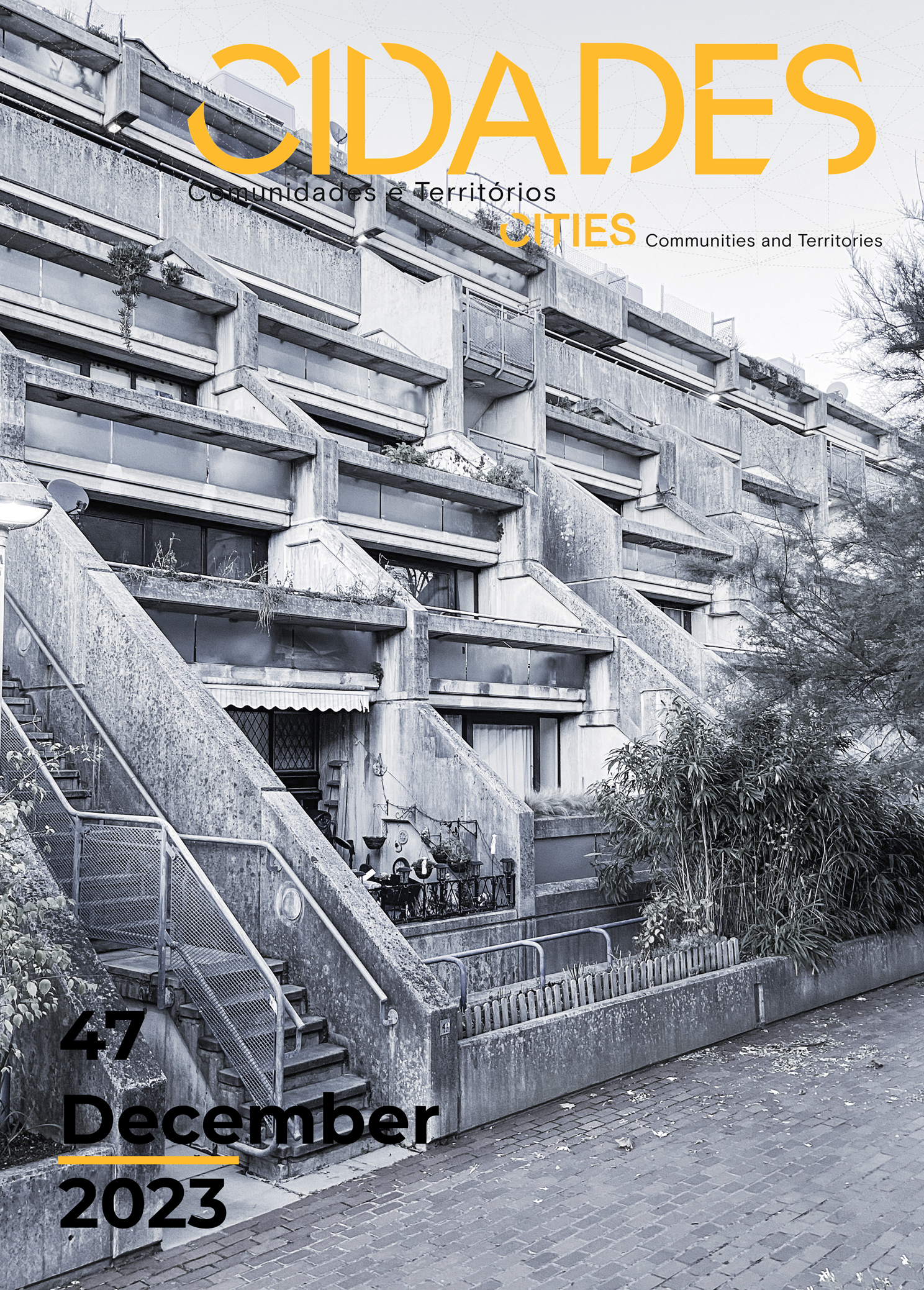An indigenous horticultural project in Rio de Janeiro as a gap in formal urban space
The case of the Dja Guata Porã Garden
Keywords:
urbanism, ethnography, social housing in BrazilAbstract
This paper proposes the problematization of generic and mass-produced forms of architecture through the oppositional relationship with indigenous self-constructed spaces. Starting from an ethnographic study about an unique indigenous horticulture project in the center of Rio de Janeiro, The Dja Guata Porã Garden, we demonstrate the effort to build a territory that organizes itself based on multispecies relationships. The project is contrasted with the formal urban space where it takes place, within a housing complex “Minha Casa, Minha Vida”, the largest public housing policy in Brazil, where the architecture is designed with generic spaces that cannot be modified according to the residents. From this spatial contrast, we propose that this indigenous horticulture project, with pedagogical purposes, is a gap in the formal urban space.
References
Amoedo, M. N. (2019). O espaço apropriado: Um estudo acerca do Conjunto Ismael Silva e Zé Keti na cidade do Rio de Janeiro. [Master’s thesis, Faculdade de Arquitectura da Universidade do Porto].
Balée, W. L. (2013). Cultural forests of the Amazon: A historical ecology of people and their landscapes. University of Alabama Press.
Berenstein, P. J., & Junior, D. L. A.. (2017, , July 08). A construção de Brasília: Alguns silenciamentos e um afogamento. In XII Encontro de História da Arte Unicamp. Campinas, SP.
Brand,S.(1995). How buildings learn: what happens after they’re built.: Viking Press.
Cançado,W.(2019). Under the pavement, the forest: city and cosmopolitics. [Tese de doutoramento, Universidade Federal de Minas Gerais].
Castro, E, V. (2017) Os Involuntários da Pátria: Elogio do subdesenvolvimento. Caderno de Leituras: Série Intempestiva, 65, 1-9.
Castro, E. V., & Danowski, D. (2017). Há um mundo por vir? Ensaio sobre os medos e os fins. Editora ISA.
Censo Brasileiro de 2010. (2012) .Instituto Brasileiro de Geografia e Estatística (IBGE).
Clement, C. R., Denevan, W. M., Heckenberger, M. J., Junqueira, A. B., Neves, E. G., Teixeira, W. G., & Woods, W. I. (2015). The domestication of Amazonia before European conquest. Proceedings of the Royal Society, 282, 1-9. https://doi.org/10.1098/rspb.2015.0813
Clément, G. (2018). Manifiesto del Tercer Paisaje. Editora Gustavo Gili.
Correia, M., Calisto, A. M., Doherty, G., & Valenzuela, L. (2019). Ecological Urbanism in Latin America.. Editora Gustavo Gili
ENTRE(Ed.). (2019). 8 Reações para o Depois. Rio Books.
Guirau, K. M. & Silva, C. R. (2013). Povos Indígenas no espaço urbano e políticas públicas. Universidade Estadual Paulista, 1, 2-25.
Haraway, D. (2015). Anthropocene, Capitalocene, Plantationocene, Chthulucene: Making Kin. Environmental Humanities, 6 (1), 159–165. https://doi.org/10.1215/22011919-3615934
Ingold, T. (2000). The Perception of the Environment: Essays on Livelihood, Dwelling and Skill. Taylor & Francis
Ingold, T. (2010). Bringing Things to Life: Creative Entanglements in a World of Materials. Realities Working Papers/University of Manchester, 15, 1-16. http://eprints.ncrm.ac.uk/1306/
Ingold, T. (2011). Being alive: essays on movement, knowledge and description. Routledge.
Ingold, T. (2013). Making: anthropology, archaeology, art and architecture. Routledge.
Instituto Escolhas e Folha realizam seminário sobre moradia e expansão das metrópoles. (2019, January 14) Folha de São Paulo. https://www1.folha.uol.com.br/seminariosfolha/2019/01/
Kopenawa, D. & Albert, B. (2015). A Queda do Céu: Palavras de um xamã Yanomami. Companhia das Letras.
Krenak, A. (2018). A Potência do Sujeito Coletivo - Entrevista. Revista Periferias, 1. https://revistaperiferias.org/materia/a-potencia-do-sujeito-coletivo-parte-i/
Krenak, A. (2019). Ideias para Adiar o Fim do Mundo Companhia das Letras.
Krenak, A. (2019). Entrevista Ailton Krenak. In G. Kozlowski, A. Altberg & M. Meneguetti (Eds.), 8 Reações para o Depois (1rd ed, 87-93). Rio Books.
Lagrou, E. (2018) Copernicus in the amazon: ontological turnings from the perspective of amerindian ethnologies. Sociologia & Antropologia - Programa de Pós-Graduação em Sociologia e Antropologia/UFRJ, 8 (1). https://doi.org/10.1590/2238-38752017v815
Merleau-Ponty, M. (1962). Phenomenology of perception. Routledge & Kegan Paul.
Name, L. & Moassab, A. (2014). Por um ensino de paisagismo crítico e emancipatório na América Latina: um debate sobre tipos e paisagens dominantes e subalternos. In Name, L. & Moassab, A.(Eds.), Por um ensino insurgente em arquitetura e urbanismo. (1rd ed., pp. 336-348). Editora da Universidade Federal de Integração Latino Americana - UNILA.
Rolnik, R. (2001). São Paulo. Folha de São Paulo.
Rolnik, R. (2015). Guerra dos Lugares. Boitempo.
Rolnik, R., Pereira, A. L. S., Moreira, F. A., et al. (2015). O Programa Minha Casa, Minha Vida nas regiões metropolitanas de São Paulo e Campinas: aspectos socioespaciais e segregação. Cadernos Metrópole, 17, 127–154. http://dx.doi.org/10.1590/2236-9996.2023-5700
Siza, A. (1997). Alvaro Siza: Writings on Architecture. Skira Editore.
Solà-Morales, I. (1995). Terrain vague. In C. Davidson (Ed.), Anyplace (1rd ed., pp. 118-123). The MIT Press.
Tavares, P. (2016). In The Forest Ruins. Brasília.
Tavares, P. (2019). Entrevista Paulo Tavares. In G. Kozlowski, A. Altberg & M. Meneguetti (Eds.), 8 Reações para o Depois (1rd ed, 87-93). Rio Books
Tsing, A. (2019). Living in Ruins: Multispecies Landscapes in the Anthropocene. Princeton University Press
Downloads
Published
Issue
Section
License
Copyright (c) 2023 Camila Bevilaqua Afonso, Priscila Martins de Melo

This work is licensed under a Creative Commons Attribution-NonCommercial-NoDerivatives 4.0 International License.
Cidades, Comunidades e Territórios by DINÂMIA'CET-IUL is licensed under a Creative Commons Atribuição-Uso Não-Comercial-Proibição de realização de Obras Derivadas 4.0 Unported License.Permissions beyond the scope of this license may be available at mailto:cidades.dinamiacet@iscte.pt.






